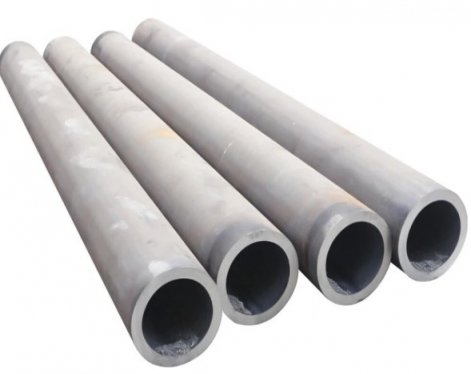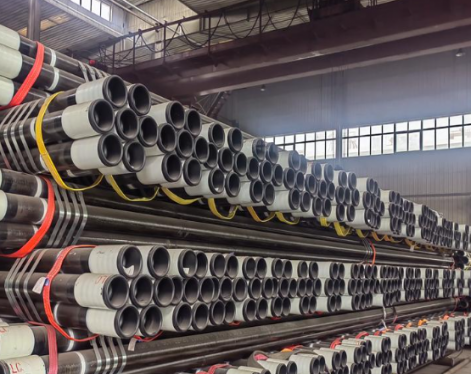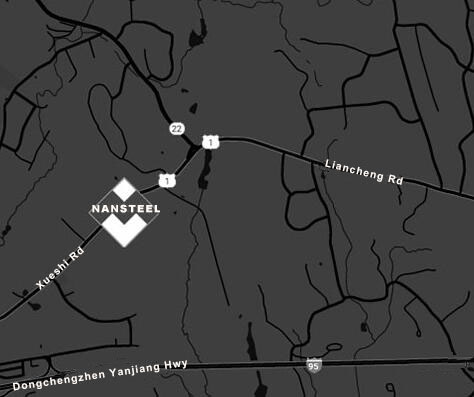The lifespan of seamless steel pipes is a complex issue, with no fixed value. Its service life is affected by a combination of factors, ranging from a few years to decades or even hundreds of years. Nansteel Manufacturing Co., Ltd. has carefully summarized the four key factors that affect the lifespan of seamless steel pipes.
Key factors affecting the life of seamless steel pipes
1. Material Quality
Chemical Composition and Purity: High-quality steel, with low impurities and a stable chemical composition, produces a denser, more uniform grain structure, resulting in better mechanical properties and corrosion resistance.
Production Process: Precision manufacturing processes, such as strict rolling, cold drawing, heat treatment, and finishing controls, ensure that the steel pipe's dimensional accuracy, surface finish, metallographic structure, and mechanical properties meet design requirements, minimizing internal defects.
Defects: Any minor internal or external defects (such as cracks, slag inclusions, pores, and dents) can become the starting point for corrosion or stress concentration, significantly shortening its service life.
2. Usage Environment
Medium properties: The corrosiveness of the conveying medium is the most critical factor affecting the service life.
Water: The pH value, oxygen content, chloride ions, sulfate ions, hardness and flow rate of water all affect corrosion. For example, high chloride ion environments (such as seawater or coastal areas) will accelerate pitting corrosion.
Oil and gas: Hydrogen sulfide (H2S), carbon dioxide (CO2), chlorides, etc. in oil and gas can cause sulfide stress corrosion cracking (SSC), CO2 corrosion, etc.
Chemicals: Various acids, alkalis, salts and other chemical media have different corrosion effects on steel pipes, so specific corrosion-resistant alloys need to be selected.

3. Temperature and pressure:
High temperatures: High temperatures accelerate oxidation and creep (deformation over time under constant load) in steel, reducing its strength.
High pressure: Long-term operation at high pressures near the design limit can accelerate fatigue damage.
External environment: The soil corrosiveness (pH value, resistivity, water content, microorganisms), atmospheric environment (humidity, industrial pollutants, salt spray), sun and rain in the buried environment will affect the corrosion of the outer wall.
4. Pipeline design and construction
Design rationality: Correctly select pipe materials (material, wall thickness), calculate pressure levels, consider thermal expansion and contraction, water hammer effect, etc., to ensure that the design meets actual working conditions.
Installation quality: Welding quality (especially welds at joints), support and hanger settings, and reasonable pipeline layout will affect stress distribution and vibration, and thus affect service life. Improper installation may cause stress concentration or external damage.
Anti-corrosion layer construction: If there is an external or internal anti-corrosion layer, its construction quality (uniformity, thickness, adhesion, and presence of defects) directly determines the anti-corrosion effect and life.
Regular Inspections: Regularly perform wall thickness testing (such as ultrasonic thickness measurement), visual inspections, and non-destructive testing (such as radiography and eddy current testing) to promptly detect and address early corrosion or damage.
Maintenance: Promptly remove dirt and deposits from both inside and outside the pipeline, repair damaged anti-corrosion coatings, and perform necessary cleaning and passivation (for stainless steel).
Stress Relief: For certain high-pressure pipelines, regular post-weld heat treatment or stress relief may help extend their service life.
Typical lifespan ranges for different applications and materials
1. Ordinary Carbon Steel Seamless Pipe
In a mild atmosphere or neutral water environment, with proper corrosion protection and maintenance, the service life may be 10-50 years.
In a more corrosive environment or with improper maintenance, the service life will be significantly shortened.
2. Stainless steel seamless pipe (such as 304/316L)
In normal atmosphere, water, or generally corrosive media, its service life can typically reach 50-100 years or even longer due to its inherent corrosion resistance.
However, in environments high in chloride ions (such as seawater and coastal areas) or certain strong acid and alkaline environments, pitting or crevice corrosion may occur, shortening its service life.
3. High-Pressure alloy seamless steel pipes
For example, pipes used in power plant boilers (P91/P92) or petrochemical applications (P22) typically have a design life of 30-60 years, but this is only achieved under strict design, operation, and maintenance conditions.
Conclusion
There is no unified "standard" for the life of seamless steel pipes. It is a dynamic result that depends on the quality of the material itself, the severity of the environment, the design and installation quality of the pipeline, and the level of subsequent operation and maintenance. By selecting high-quality pipes, conducting reasonable design, standardized installation and continuous maintenance, the service life of seamless steel pipes can be maximized to ensure the long-term safe and reliable operation of the pipeline system.
Read more: How to prolong the service life of seamless pipe
Key factors affecting the life of seamless steel pipes
1. Material Quality
Chemical Composition and Purity: High-quality steel, with low impurities and a stable chemical composition, produces a denser, more uniform grain structure, resulting in better mechanical properties and corrosion resistance.
Production Process: Precision manufacturing processes, such as strict rolling, cold drawing, heat treatment, and finishing controls, ensure that the steel pipe's dimensional accuracy, surface finish, metallographic structure, and mechanical properties meet design requirements, minimizing internal defects.
Defects: Any minor internal or external defects (such as cracks, slag inclusions, pores, and dents) can become the starting point for corrosion or stress concentration, significantly shortening its service life.
2. Usage Environment
Medium properties: The corrosiveness of the conveying medium is the most critical factor affecting the service life.
Water: The pH value, oxygen content, chloride ions, sulfate ions, hardness and flow rate of water all affect corrosion. For example, high chloride ion environments (such as seawater or coastal areas) will accelerate pitting corrosion.
Oil and gas: Hydrogen sulfide (H2S), carbon dioxide (CO2), chlorides, etc. in oil and gas can cause sulfide stress corrosion cracking (SSC), CO2 corrosion, etc.
Chemicals: Various acids, alkalis, salts and other chemical media have different corrosion effects on steel pipes, so specific corrosion-resistant alloys need to be selected.

3. Temperature and pressure:
High temperatures: High temperatures accelerate oxidation and creep (deformation over time under constant load) in steel, reducing its strength.
High pressure: Long-term operation at high pressures near the design limit can accelerate fatigue damage.
External environment: The soil corrosiveness (pH value, resistivity, water content, microorganisms), atmospheric environment (humidity, industrial pollutants, salt spray), sun and rain in the buried environment will affect the corrosion of the outer wall.
4. Pipeline design and construction
Design rationality: Correctly select pipe materials (material, wall thickness), calculate pressure levels, consider thermal expansion and contraction, water hammer effect, etc., to ensure that the design meets actual working conditions.
Installation quality: Welding quality (especially welds at joints), support and hanger settings, and reasonable pipeline layout will affect stress distribution and vibration, and thus affect service life. Improper installation may cause stress concentration or external damage.
Anti-corrosion layer construction: If there is an external or internal anti-corrosion layer, its construction quality (uniformity, thickness, adhesion, and presence of defects) directly determines the anti-corrosion effect and life.
5. Operation and maintenance
Operating Standards: Avoid overpressure and overtemperature operation, and avoid excessive media flow rates that may cause erosion, corrosion, or cavitation.Regular Inspections: Regularly perform wall thickness testing (such as ultrasonic thickness measurement), visual inspections, and non-destructive testing (such as radiography and eddy current testing) to promptly detect and address early corrosion or damage.
Maintenance: Promptly remove dirt and deposits from both inside and outside the pipeline, repair damaged anti-corrosion coatings, and perform necessary cleaning and passivation (for stainless steel).
Stress Relief: For certain high-pressure pipelines, regular post-weld heat treatment or stress relief may help extend their service life.
Typical lifespan ranges for different applications and materials
1. Ordinary Carbon Steel Seamless Pipe
In a mild atmosphere or neutral water environment, with proper corrosion protection and maintenance, the service life may be 10-50 years.
In a more corrosive environment or with improper maintenance, the service life will be significantly shortened.
2. Stainless steel seamless pipe (such as 304/316L)
In normal atmosphere, water, or generally corrosive media, its service life can typically reach 50-100 years or even longer due to its inherent corrosion resistance.
However, in environments high in chloride ions (such as seawater and coastal areas) or certain strong acid and alkaline environments, pitting or crevice corrosion may occur, shortening its service life.
3. High-Pressure alloy seamless steel pipes
For example, pipes used in power plant boilers (P91/P92) or petrochemical applications (P22) typically have a design life of 30-60 years, but this is only achieved under strict design, operation, and maintenance conditions.
Conclusion
There is no unified "standard" for the life of seamless steel pipes. It is a dynamic result that depends on the quality of the material itself, the severity of the environment, the design and installation quality of the pipeline, and the level of subsequent operation and maintenance. By selecting high-quality pipes, conducting reasonable design, standardized installation and continuous maintenance, the service life of seamless steel pipes can be maximized to ensure the long-term safe and reliable operation of the pipeline system.
Read more: How to prolong the service life of seamless pipe









